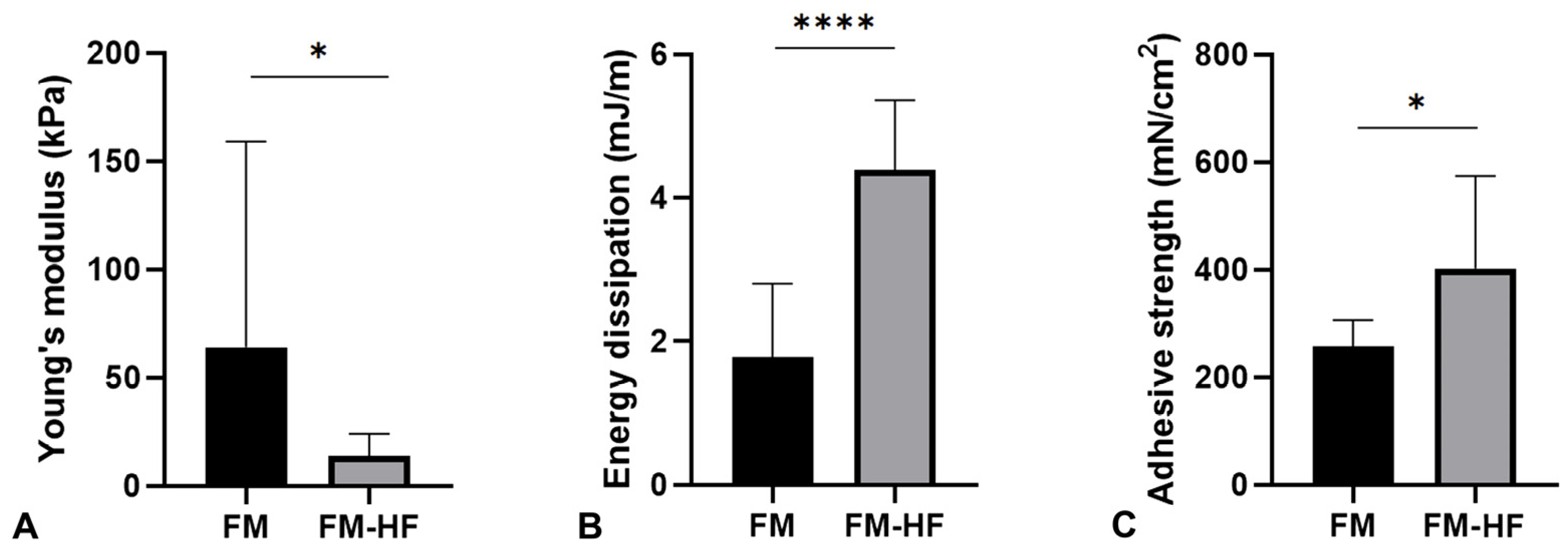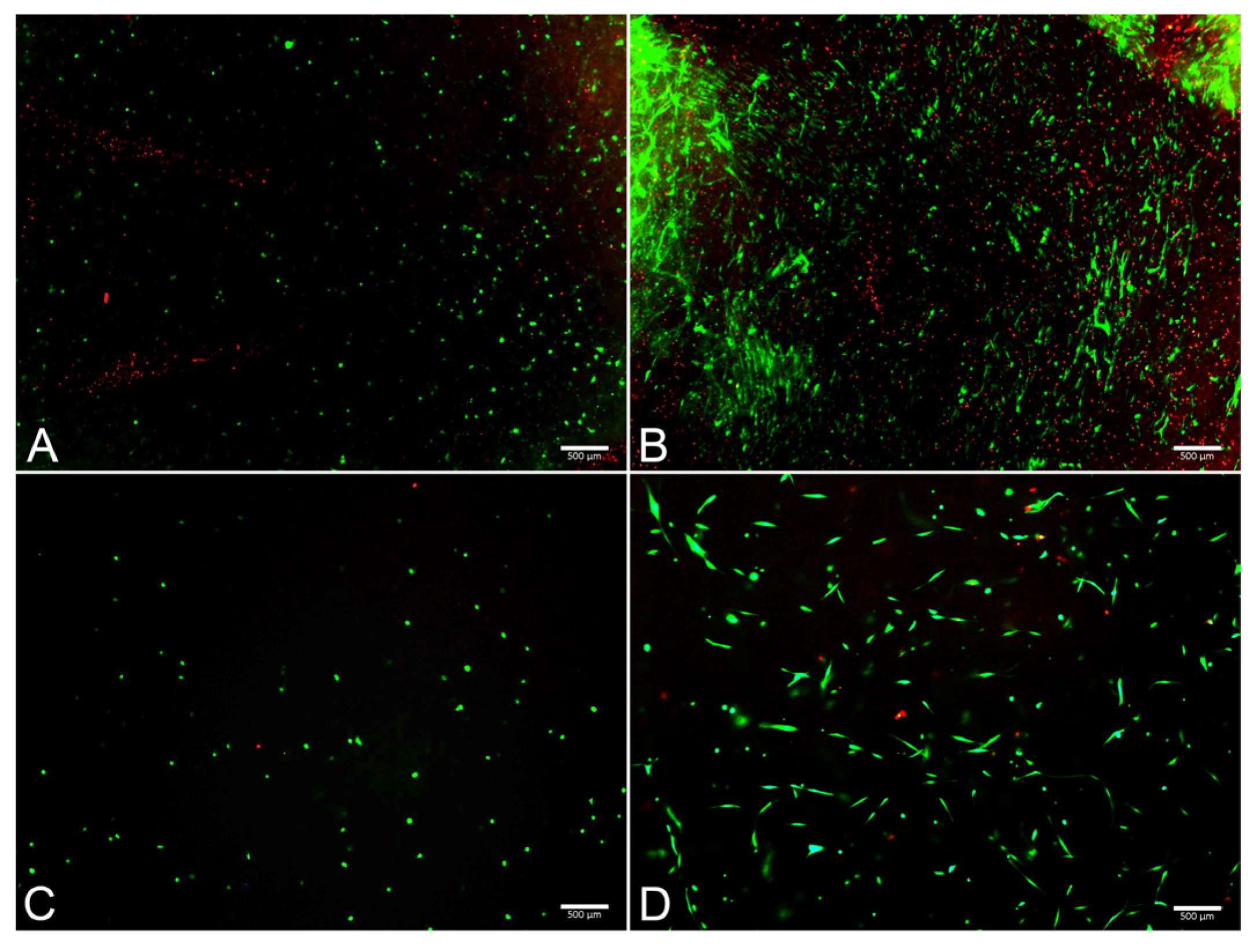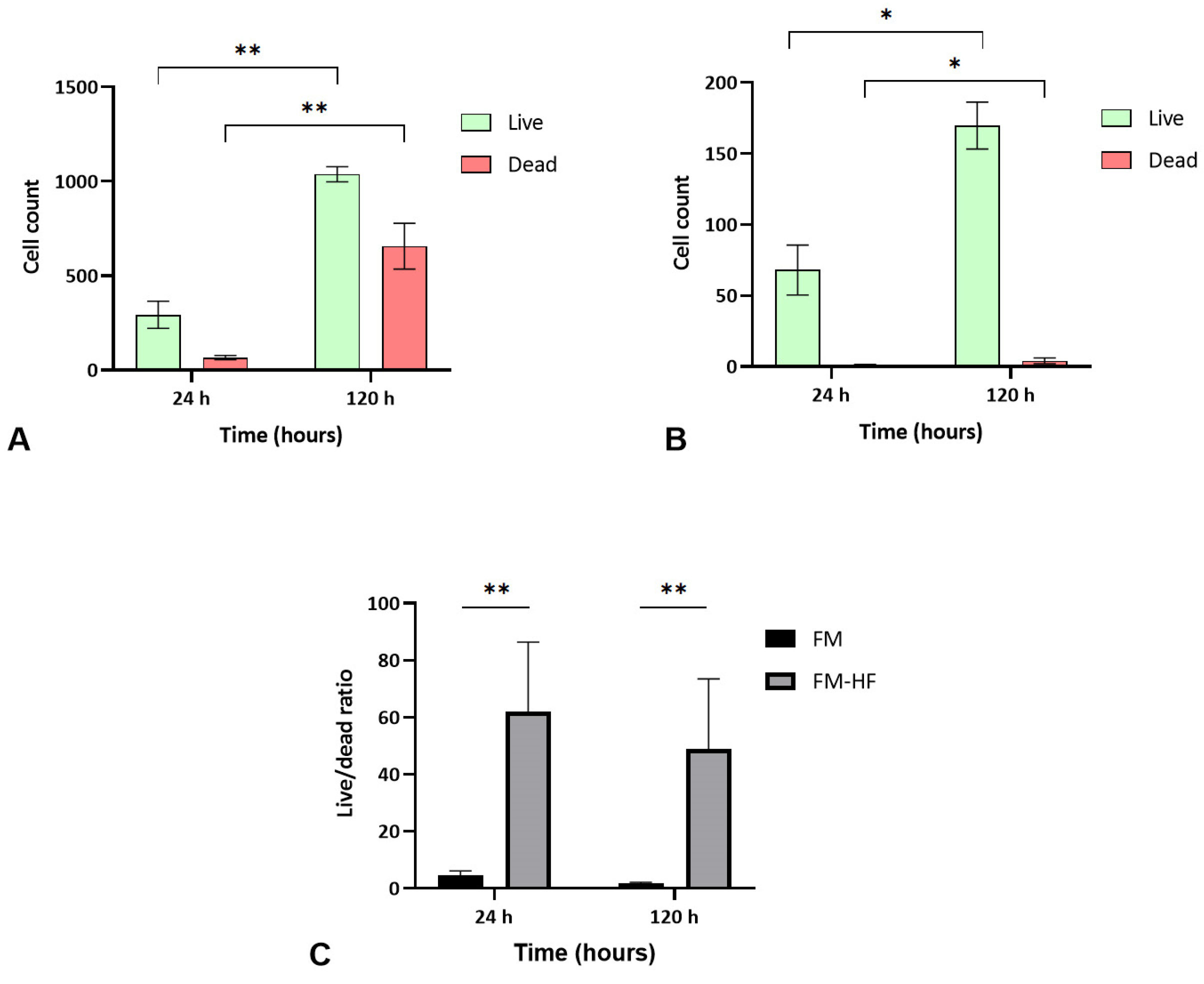A Novel Fibrin Matrix Derived from Platelet-Rich Plasma: Protocol and Characterization
Abstract
1. Introduction
2. Results
2.1. Fibrinogen Concentration
2.2. Clotting, Swelling and Retraction of the Matrices
2.3. Biomechanical Properties of the Matrices
2.4. Cellular Viability of the Dermal Fibroblasts Seeded in the FM-HF and FM
3. Discussion
4. Materials and Methods
4.1. Preparation of the Formulations
4.1.1. PRP-Derived Fibrin Matrix (FM)
4.1.2. The PRP-Derived Fibrin Matrix with a High Fibrinogen Content and Platelets (FM-HFP)
4.1.3. The PRP-Derived Fibrin Matrix with a High Fibrinogen Content (FM-HF)
4.2. Fibrinogen Level Measurements
4.3. Clotting, Swelling and Retraction
4.4. Mechanical Tests
4.5. Cell Assays
4.6. Statistical Analysis
5. Conclusions
Supplementary Materials
Author Contributions
Funding
Institutional Review Board Statement
Informed Consent Statement
Data Availability Statement
Acknowledgments
Conflicts of Interest
References
- Everts, P.; Onishi, K.; Jayaram, P.; Lana, J.F.; Mautner, K. Platelet-Rich Plasma: New Performance Understandings and Therapeutic Considerations in 2020. Int. J. Mol. Sci. 2020, 21, 7794. [Google Scholar] [CrossRef] [PubMed]
- Coulange Zavarro, A.; De Girolamo, L.; Laver, L.; Sánchez, M.; Tischer, T.; Filardo, G.; Sabatier, F.; Magalon, J. The Top 100 Most Cited Articles on Platelet-Rich Plasma Use in Regenerative Medicine-A Bibliometric Analysis-From the ESSKA Orthobiologic Initiative. Bioengineering 2022, 9, 580. [Google Scholar] [CrossRef] [PubMed]
- Everts, P.A.M.; Knape, J.T.A.; Weibrich, G.; Schönberger, J.P.A.M.; Hoffmann, J.; Overdevest, E.P.; Box, H.A.M.; van Zundert, A. Platelet-Rich Plasma and Platelet Gel: A Review. J. Extra. Corpor. Technol. 2006, 38, 174–187. [Google Scholar] [CrossRef] [PubMed]
- Weisel, J.W. Fibrinogen and Fibrin. In Advances in Protein Chemistry; Elsevier: Amsterdam, The Netherlands, 2005; Volume 70, pp. 247–299. ISBN 978-0-12-034270-9. [Google Scholar]
- Sánchez-González, D.J.; Méndez-Bolaina, E.; Trejo-Bahena, N.I. Platelet-Rich Plasma Peptides: Key for Regeneration. Int. J. Pept. 2012, 2012, 532519. [Google Scholar] [CrossRef] [PubMed]
- Beitia, M.; Delgado, D.; Mercader, J.; Sánchez, P.; López de Dicastillo, L.; Sánchez, M. Action of Platelet-Rich Plasma on In Vitro Cellular Bioactivity: More than Platelets. Int. J. Mol. Sci. 2023, 24, 5367. [Google Scholar] [CrossRef] [PubMed]
- Anitua, E.; Prado, R.; Azkargorta, M.; Rodriguez-Suárez, E.; Iloro, I.; Casado-Vela, J.; Elortza, F.; Orive, G. High-Throughput Proteomic Characterization of Plasma Rich in Growth Factors (PRGF-Endoret)-Derived Fibrin Clot Interactome. J. Tissue Eng. Regen. Med. 2015, 9, E1–E12. [Google Scholar] [CrossRef] [PubMed]
- Mosher, D.F.; Misenheimer, T.M.; Stenflo, J.; Hogg, P.J. Modulation of Fibrinolysis by Thrombospondin. Ann. N. Y. Acad. Sci. 1992, 667, 64–69. [Google Scholar] [CrossRef]
- Hasumi, K.; Yamamichi, S.; Harada, T. Small-Molecule Modulators of Zymogen Activation in the Fibrinolytic and Coagulation Systems. FEBS J. 2010, 277, 3675–3687. [Google Scholar] [CrossRef] [PubMed]
- Anitua, E.; Pino, A. The Management of Postsurgical Wound Complications with Plasma Rich in Growth Factors: A Preliminary Series. Adv. Skin Wound Care 2020, 33, 202–208. [Google Scholar] [CrossRef] [PubMed]
- Sánchez, M.; Delgado, D.; Sánchez, P.; Fiz, N.; Azofra, J.; Orive, G.; Anitua, E.; Padilla, S. Platelet Rich Plasma and Knee Surgery. BioMed. Res. Int. 2014, 2014, 890630. [Google Scholar] [CrossRef] [PubMed]
- Dohan Ehrenfest, D.M.; Bielecki, T.; Jimbo, R.; Barbé, G.; Del Corso, M.; Inchingolo, F.; Sammartino, G. Do the Fibrin Architecture and Leukocyte Content Influence the Growth Factor Release of Platelet Concentrates? An Evidence-Based Answer Comparing a Pure Platelet-Rich Plasma (P-PRP) Gel and a Leukocyte- and Platelet-Rich Fibrin (L-PRF). Curr. Pharm. Biotechnol. 2012, 13, 1145–1152. [Google Scholar] [CrossRef] [PubMed]
- Anitua, E.; Zalduendo, M.M.; Prado, R.; Alkhraisat, M.H.; Orive, G. Morphogen and Proinflammatory Cytokine Release Kinetics from PRGF-Endoret Fibrin Scaffolds: Evaluation of the Effect of Leukocyte Inclusion. J. Biomed. Mater. Res. A 2015, 103, 1011–1020. [Google Scholar] [CrossRef] [PubMed]
- Anitua, E.; Prado, R.; Sánchez, M.; Orive, G. Platelet-Rich Plasma: Preparation and Formulation. Oper. Tech. Orthop. 2012, 22, 25–32. [Google Scholar] [CrossRef]
- Mehdizadeh, M.; Yang, J. Design Strategies and Applications of Tissue Bioadhesives. Macromol. Biosci. 2013, 13, 271–288. [Google Scholar] [CrossRef] [PubMed]
- Portilla-de Buen, E.; Orozco-Mosqueda, A.; Leal-Cortés, C.; Vázquez-Camacho, G.; Fuentes-Orozco, C.; Alvarez-Villaseñor, A.S.; Macías-Amezcua, M.D.; González-Ojeda, A. Fibrinogen and Thrombin Concentrations Are Critical for Fibrin Glue Adherence in Rat High-Risk Colon Anastomoses. Clinics 2014, 69, 259–264. [Google Scholar] [CrossRef]
- Nurden, A.T. Molecular Basis of Clot Retraction and Its Role in Wound Healing. Thromb. Res. 2022, 231, 159–169. [Google Scholar] [CrossRef] [PubMed]
- Sánchez, M.; Delgado, D.; Garate, A.; Sánchez, P.; Padilla, S.; Azofra, J. Platelet-Rich Plasma Combined with Allograft to Treat Osteochondritis Dissecans of the Knee: A Case Report. J. Med. Case Rep. 2019, 13, 105. [Google Scholar] [CrossRef] [PubMed]
- Kim, B.-S.; Sung, H.-M.; You, H.-K.; Lee, J. Effects of Fibrinogen Concentration on Fibrin Glue and Bone Powder Scaffolds in Bone Regeneration. J. Biosci. Bioeng. 2014, 118, 469–475. [Google Scholar] [CrossRef] [PubMed]
- Kim, B.-S.; Kim, H.-J.; Choi, J.-G.; You, H.-K.; Lee, J. The Effects of Fibrinogen Concentration on Fibrin/Atelocollagen Composite Gel: An in Vitro and in Vivo Study in Rabbit Calvarial Bone Defect. Clin. Oral Implant. Res. 2015, 26, 1302–1308. [Google Scholar] [CrossRef]
- Nandi, S.; Sommerville, L.; Nellenbach, K.; Mihalko, E.; Erb, M.; Freytes, D.O.; Hoffman, M.; Monroe, D.; Brown, A.C. Platelet-like Particles Improve Fibrin Network Properties in a Hemophilic Model of Provisional Matrix Structural Defects. J. Colloid Interface Sci. 2020, 577, 406–418. [Google Scholar] [CrossRef]
- Dickneite, G.; Metzner, H.; Pfeifer, T.; Kroez, M.; Witzke, G. A Comparison of Fibrin Sealants in Relation to Their in Vitro and in Vivo Properties. Thromb. Res. 2003, 112, 73–82. [Google Scholar] [CrossRef] [PubMed]
- Düregger, K.; Frenzel, S.; Eblenkamp, M. Autologous Fibrin Glue: Automated Production and Adhesive Quality. Curr. Dir. Biomed. Eng. 2017, 3, 397–400. [Google Scholar] [CrossRef]
- Kjaergard, H.K.; Weis-Fogh, U.S.; Sørensen, H.; Thiis, J.; Rygg, I. Autologous Fibrin Glue—Preparation and Clinical Use in Thoracic Surgery. Eur. J. Cardio-Thorac. Surg. Off. J. Eur. Assoc. Cardio-Thorac. Surg. 1992, 6, 52–54; discussion 54. [Google Scholar] [CrossRef] [PubMed]
- Thorn, J.J.; Sørensen, H.; Weis-Fogh, U.; Andersen, M. Autologous Fibrin Glue with Growth Factors in Reconstructive Maxillofacial Surgery. Int. J. Oral Maxillofac. Surg. 2004, 33, 95–100. [Google Scholar] [CrossRef] [PubMed]
- Zhang, Z.; Zhong, W.; Li, J.; Luo, J. Mechanical Properties and Cushioning Effectiveness of FPUF-EPS Combination Materials. Materials 2023, 16, 6886. [Google Scholar] [CrossRef]
- Buchta, C.; Hedrich, H.C.; Macher, M.; Höcker, P.; Redl, H. Biochemical Characterization of Autologous Fibrin Sealants Produced by CryoSeal and Vivostat in Comparison to the Homologous Fibrin Sealant Product Tissucol/Tisseel. Biomaterials 2005, 26, 6233–6241. [Google Scholar] [CrossRef]
- Kjaergard, H.K.; Velada, J.L.; Pedersen, J.H.; Fleron, H.; Hollingsbee, D.A. Comparative Kinetics of Polymerisation of Three Fibrin Sealants and Influence on Timing of Tissue Adhesion. Thromb. Res. 2000, 98, 221–228. [Google Scholar] [CrossRef] [PubMed]
- Irwin, R.M.; Bonassar, L.J.; Cohen, I.; Matuska, A.M.; Commins, J.; Cole, B.; Fortier, L.A. The Clot Thickens: Autologous and Allogeneic Fibrin Sealants Are Mechanically Equivalent in an Ex Vivo Model of Cartilage Repair. PLoS ONE 2019, 14, e0224756. [Google Scholar] [CrossRef]
- Jansen, E.E.; Hartmann, M. Clot Retraction: Cellular Mechanisms and Inhibitors, Measuring Methods, and Clinical Implications. Biomedicines 2021, 9, 1064. [Google Scholar] [CrossRef]
- Huang, G.; Hua, S.; Yang, T.; Ma, J.; Yu, W.; Chen, X. Platelet-Rich Plasma Shows Beneficial Effects for Patients with Knee Osteoarthritis by Suppressing Inflammatory Factors. Exp. Ther. Med. 2018, 15, 3096–3102. [Google Scholar] [CrossRef] [PubMed]
- Zaninetti, C.; Sachs, L.; Palankar, R. Role of Platelet Cytoskeleton in Platelet Biomechanics: Current and Emerging Methodologies and Their Potential Relevance for the Investigation of Inherited Platelet Disorders. Hämostaseologie 2020, 40, 337–347. [Google Scholar] [CrossRef] [PubMed]
- Everts, P.A.; Sadeghi, P.; Smith, D.R. Basic Science of Autologous Orthobiologics: Part 1. Platelet-Rich Plasma. Phys. Med. Rehabil. Clin. N. Am. 2023, 34, 1–23. [Google Scholar] [CrossRef] [PubMed]
- Cavallo, C.; Roffi, A.; Grigolo, B.; Mariani, E.; Pratelli, L.; Merli, G.; Kon, E.; Marcacci, M.; Filardo, G. Platelet-Rich Plasma: The Choice of Activation Method Affects the Release of Bioactive Molecules. BioMed. Res. Int. 2016, 2016, 6591717. [Google Scholar] [CrossRef] [PubMed]
- Padilla, S.; Sánchez, M.; Vaquerizo, V.; Malanga, G.A.; Fiz, N.; Azofra, J.; Rogers, C.J.; Samitier, G.; Sampson, S.; Seijas, R.; et al. Platelet-Rich Plasma Applications for Achilles Tendon Repair: A Bridge between Biology and Surgery. Int. J. Mol. Sci. 2021, 22, 824. [Google Scholar] [CrossRef] [PubMed]
- Anitua, E.; Zalduendo, M.M.; Alkhraisat, M.H.; Orive, G. Release kinetics of platelet-derived and plasma-derived growth factors from autologous plasma rich in growth factors. Ann Anat. 2013, 195, 461–466. [Google Scholar] [CrossRef]
- Cha, C.; Kim, S.Y.; Cao, L.; Kong, H. Decoupled Control of Stiffness and Permeability with a Cell-Encapsulating Poly(Ethylene Glycol) Dimethacrylate Hydrogel. Biomaterials 2010, 31, 4864–4871. [Google Scholar] [CrossRef] [PubMed]
- Abdel-Sayed, P.; Darwiche, S.E.; Kettenberger, U.; Pioletti, D.P. The Role of Energy Dissipation of Polymeric Scaffolds in the Mechanobiological Modulation of Chondrogenic Expression. Biomaterials 2014, 35, 1890–1897. [Google Scholar] [CrossRef] [PubMed]
- Padilla, S.; Sánchez, M.; Orive, G.; Anitua, E. Human-Based Biological and Biomimetic Autologous Therapies for Musculoskeletal Tissue Regeneration. Trends Biotechnol. 2017, 35, 192–202. [Google Scholar] [CrossRef] [PubMed]
- Balagholi, S.; Rezaei Kanavi, M.; Alizadeh, S.; Dabbaghi, R.; Karami, S.; Kheiri, B.; Daftarian, N. Effects of Fibrin Glue as a Three-Dimensional Scaffold in Cultivated Adult Human Retinal Pigment Epithelial Cells. J. Biomater. Appl. 2018, 33, 514–526. [Google Scholar] [CrossRef] [PubMed]
- Hanson, A.J.; Quinn, M.T. Effect of Fibrin Sealant Composition on Human Neutrophil Chemotaxis. J. Biomed. Mater. Res. 2002, 61, 474–481. [Google Scholar] [CrossRef] [PubMed]
- Ho, W.; Tawil, B.; Dunn, J.C.Y.; Wu, B.M. The Behavior of Human Mesenchymal Stem Cells in 3D Fibrin Clots: Dependence on Fibrinogen Concentration and Clot Structure. Tissue Eng. 2006, 12, 1587–1595. [Google Scholar] [CrossRef] [PubMed]
- Hale, B.W.; Goodrich, L.R.; Frisbie, D.D.; McIlwraith, C.W.; Kisiday, J.D. Effect of Scaffold Dilution on Migration of Mesenchymal Stem Cells from Fibrin Hydrogels. Am. J. Vet. Res. 2012, 73, 313–318. [Google Scholar] [CrossRef] [PubMed]
- Bensaïd, W.; Triffitt, J.T.; Blanchat, C.; Oudina, K.; Sedel, L.; Petite, H. A Biodegradable Fibrin Scaffold for Mesenchymal Stem Cell Transplantation. Biomaterials 2003, 24, 2497–2502. [Google Scholar] [CrossRef] [PubMed]
- Mason, E.F.; Rathmell, J.C. Cell Metabolism: An Essential Link between Cell Growth and Apoptosis. Biochim. Biophys. Acta BBA Mol. Cell Res. 2011, 1813, 645–654. [Google Scholar] [CrossRef] [PubMed]
- Hickerson, W.L.; Nur, I.; Meidler, R. A comparison of the mechanical, kinetic, and biochemical properties of fibrin clots formed with two different fibrin sealants. Blood Coagul. Fibrinolysis 2011, 22, 19–23. [Google Scholar] [CrossRef] [PubMed]
- Anitua, E.; Muruzabal, F.; Prado, R.; Pino, A.; Tierno, R.; Persinal-Medina, M.; Alkhraisat, M.H.; Merayo-Lloves, J. Biological and Adhesive Properties of an Autologous Protein-Based Fibrin Sealant for Ophthalmological Applications. Transl. Vis. Sci. Technol. 2023, 12, 32. [Google Scholar] [CrossRef] [PubMed]






| FM | FM-HF | p Value | |
|---|---|---|---|
| Wi (g) (mean ± SD) | 0.60 ± 0.01 | 0.60 ± 0.02 | 0.742 |
| Wf (g) (mean ± SD) | 0.03 ± 0.01 | 0.50 ± 0.03 | <0.0001 **** |
| Clotting (%) (mean ± SD) | 4.46 ± 1.55 | 82.85 ± 3,54 | <0.0001 **** |
| Wd (g) (mean ± SD) | 0.01 ± 0.00 | 0.07 ± 0.00 | <0.0001 **** |
| Ww (g) (mean ± SD) | 0.02 ± 0.00 | 0.13 ± 0.00 | <0.0001 **** |
| Swelling ratio | 0.42 ± 0.12 | 0.87 ± 0.14 | <0.001 *** |
| Vi (mm3) (mean ± SD) | 102.74 ± 5.23 | 103.71 ± 4.29 | 0.756 |
| Vf (mm3) (mean ± SD) | 7.35 ± 2.10 | 100.98 ± 4.91 | <0.0001 **** |
| Retraction (%) (mean ± SD) | 92.82 ± 2.17 | 4.91 ± 1.79 | <0.0001 **** |
Disclaimer/Publisher’s Note: The statements, opinions and data contained in all publications are solely those of the individual author(s) and contributor(s) and not of MDPI and/or the editor(s). MDPI and/or the editor(s) disclaim responsibility for any injury to people or property resulting from any ideas, methods, instructions or products referred to in the content. |
© 2024 by the authors. Licensee MDPI, Basel, Switzerland. This article is an open access article distributed under the terms and conditions of the Creative Commons Attribution (CC BY) license (https://creativecommons.org/licenses/by/4.0/).
Share and Cite
Delgado, D.; Beitia, M.; Mercader Ruiz, J.; Sánchez, P.; Montoya-Alzola, M.; Fiz, N.; Sánchez, M. A Novel Fibrin Matrix Derived from Platelet-Rich Plasma: Protocol and Characterization. Int. J. Mol. Sci. 2024, 25, 4069. https://doi.org/10.3390/ijms25074069
Delgado D, Beitia M, Mercader Ruiz J, Sánchez P, Montoya-Alzola M, Fiz N, Sánchez M. A Novel Fibrin Matrix Derived from Platelet-Rich Plasma: Protocol and Characterization. International Journal of Molecular Sciences. 2024; 25(7):4069. https://doi.org/10.3390/ijms25074069
Chicago/Turabian StyleDelgado, Diego, Maider Beitia, Jon Mercader Ruiz, Pello Sánchez, Marta Montoya-Alzola, Nicolás Fiz, and Mikel Sánchez. 2024. "A Novel Fibrin Matrix Derived from Platelet-Rich Plasma: Protocol and Characterization" International Journal of Molecular Sciences 25, no. 7: 4069. https://doi.org/10.3390/ijms25074069
APA StyleDelgado, D., Beitia, M., Mercader Ruiz, J., Sánchez, P., Montoya-Alzola, M., Fiz, N., & Sánchez, M. (2024). A Novel Fibrin Matrix Derived from Platelet-Rich Plasma: Protocol and Characterization. International Journal of Molecular Sciences, 25(7), 4069. https://doi.org/10.3390/ijms25074069






